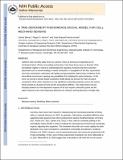A time-dependent phenomenological model for cell mechano-sensing
Author(s)
Borau, Carlos; Kamm, Roger Dale; Garcia-Aznar, Jose Manuel
DownloadKamm_A time-dependent.pdf (1.018Mb)
OPEN_ACCESS_POLICY
Open Access Policy
Creative Commons Attribution-Noncommercial-Share Alike
Terms of use
Metadata
Show full item recordAbstract
Adherent cells normally apply forces as a generic means of sensing and responding to the mechanical nature of their surrounding environment. How these forces vary as a function of the extracellular rigidity is critical to understanding the regulatory functions that drive important phenomena such as wound healing or muscle contraction. In recognition of this fact, experiments have been conducted to understand cell rigidity-sensing properties under known conditions of the extracellular environment, opening new possibilities for modeling this active behavior. In this work, we provide a physics-based constitutive model taking into account the main structural components of the cell to reproduce its most significant contractile properties such as the traction forces exerted as a function of time and the extracellular stiffness. This model shows how the interplay between the time-dependent response of the acto-myosin contractile system and the elastic response of the cell components determines the mechano-sensing behavior of single cells.
Date issued
2013-06Department
Massachusetts Institute of Technology. Department of Biological Engineering; Massachusetts Institute of Technology. Department of Mechanical EngineeringJournal
Biomechanics and Modeling in Mechanobiology
Publisher
Springer-Verlag
Citation
Borau, Carlos, Roger D. Kamm, and Jose Manuel Garcia-Aznar. “A Time-Dependent Phenomenological Model for Cell Mechano-Sensing.” Biomech Model Mechanobiol 13, no. 2 (June 20, 2013): 451–462.
Version: Author's final manuscript
ISSN
1617-7959
1617-7940